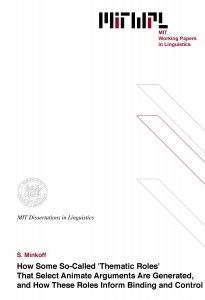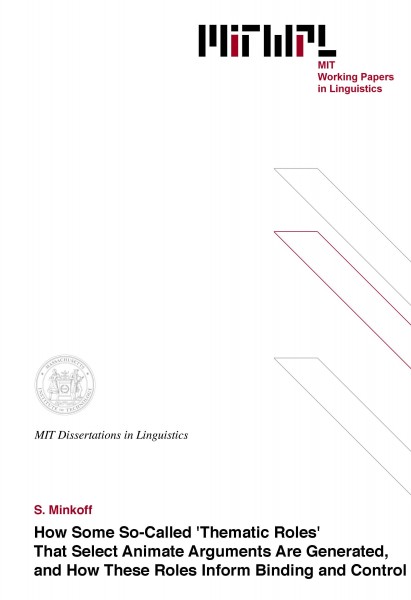How Some So-Called 'Thematic Roles' That Select Animate Arguments Are Generated, and How These Roles Inform Binding and Control
S. Minkoff, 1994
This thesis presents a theory of how the shape of lexical syntax constrains the generation of those thematic relations that require animacy in the argument to which they are attributed. The thesis shows how these relations, termed "logophoric roles", license logophoric dependencies.
Assuming throughout that branching is limited to binary (cf. Larson 1988; Kayne 1984), I show first that all logophoric roles are licensed by a single syntactic configuration: Given any two coarguments X and Y, a logophoric role can be assigned to X only if X occupies the highest theta-position within some maximal projection, and there is no logophoric role assigned to Y. This finding lends support to a modified version of Hale and Keyser"s hypothesis that all thematic relations ultimately reduce to configurations in lexical syntax.
Next, I show that the relations of self-NP binding and (non-arbitrary) control divide themselves exhaustively into two classes of dependencies: local and logophoric. This division is based in the observation that, whenever any self-NP binding or control relation overreaches a certain local domain, the antecedent argument is required to bear a logophoric role (and, consequently, the antecedent NP is required to be animate).
Local self-NP binding holds whenever a self-NP is co-indexed with a c-commanding antecedent (i.e. is bound in the sense of Chomsky 1981) within its minimal containing VP. Local control holds whenever a PRO is coindexed with a c-commanding antecedent (i.e. is bound in the sense of Chomsky 1981) within the minimal VP containing the (relevant) infinitival clause. I argue that control, properly understood, is a relation by which the controlled in fact is co-indexed with the entire infinitival clause. Thus, I conclude that a single notion of locality ultimately underlies both self-NP binding and control, and should replace standard notions of Condition A: A dependency of either kind is local only when the relevant constituent is coindexed with a c-commanding antecedent (i.e. is bound) within its minimal containing VP. I suggest, finally, that the reason that VP in particular forms the local domain for Condition A is that, given binary branching, this phrasal node constitutes the basic propositional unit in syntax.
Logophoric self-NP binding or control holds whenever a self-NP or controllee is co-indexed with a (not necessarily c-commanding) antecedent that bears a logophoric role. Logophoric dependencies are not confined to the local domain.
Since all control and self-NP binding dependencies are either local or logophoric, the theory I have developed accounts for the distribution of required logophoric roles (and hence animacy) noted above: any control or self-NP binding dependency, just if it fails to be "local" (i.e. to satisfy Condition A) in the sense described above, will effectively "force" the assignment of a logophoric role to the antecedent argument.
Finally, I argue that so-called "backwards binding" dependencies are logophoric, not licensed by the satisfaction of locality (Condition A) at d-structure as other researches have claimed. There are cases of backwards binding that cannot realistically be held to satisfy locality at d-structure or anywhere else. And moreover, in these cases and all others, the "backwards antecedent" (i.e. binder) displays the hallmark trait of a logophoric dependency, namely the appearance of requiring a logophoric role.
Thesis supervisor: Noam Chomsky
Title: Institute Professor
Table of Contents
Chapter One Introduction 10
1.1 Local and logophoric dependencies 10
1.2 Logophoric roles 18
Chapter Two A restriction on logophoric roles 22
Introduction 22
2.1 Logophoric roles 32
2.2 The distribution of permissible logophoric roles in subject and
direct object positions 38
2.3 Double object constructions 44
2.4 Dative and locative constructions 57
2.5 A general principle restricting the distribution of logophoric roles 68
Conclusion 78
Chapter Three Control theory 81
Introduction 81
3.1 Types of semantic relations between clauses 87
3.1.1 "Outer" relations 87
3.1.2 "Inner" relations 91
3.2 Control 98
3.2.1 Control by direct predication 100
3.2.2 Logophoric control 127
3.2.3 A prediction for double-control-relation sentences 137
Conclusion 138
Chapter Four A comparison between logophoric binding and the approaches of
Pestesky and Belletti and Rizzi 139
4.1 Backwards binding where c-command is impossible 142
4.2 Redrawing the boundary between logophoric binding and binding
under condition A 144
4.3 A generalization emerges in which the distinction between local
logophoric dependencies cuts across both self-NP binding and
control 161
Conclusion 165
Chapter Five Conclusion 167

